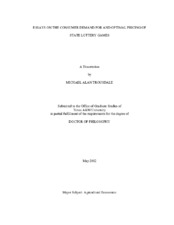| dc.description.abstract | This dissertation is a collection of three economic studies on the demand for and optimal pricing of state lottery games. Lottery betting is a multi-billion dollar industry that provides an important source of government revenue. Since lotteries operate at such a large scale, suboptimal pricing could lead to substantial losses in potential profit. This
body of work provides a significant contribution to the literature on lottery demand by
introducing a number of innovative modeling techniques that resolve major shortcomings found in current methods and provide direct policy implications for improving the profitability of state lottery games.
The first essay discusses and resolves three important issues widely overlooked in the literature on lottery demand: the treatment of observations with super-unitary expected values, controlling for the endogeneity of price, and the usefulness of estimating price elasticities evaluated at the sample mean. The second essay extends the effective price model of lottery demand into a setting where a single controller operates
a portfolio of games simultaneously. Expenditure, own-, and cross-price elasticities for several on-line lottery games are estimated with a Barten synthetic demand system.
These elasticities are used to obtain measures of price sensitivity, to determine the
degree to which these games are either complements or substitutes, and to evaluate
whether profits are maximized over the entire portfolio. Finally, the third essay
describes a new method to analyze the profitability of different pricing schemes that
explicitly accounts for the intertemporal nature of lottery games with rolling jackpots. Since period-by-period variation in sales induced by rolling jackpots causes changes in the probability that a jackpot is won, which in-turn influences the probability of reaching
new drawings with higher jackpot amounts, static analysis of lottery profitability could
lead to biased estimates of expected profit. By utilizing a Monte Carlo integration
procedure, a measure of expected profit is obtained through the simulation of lottery play over a period of four years. Hypothetical policy changes are examined to estimate
potential increases in profitability. Empirical results for the game, Lotto Texas, indicate
that a $0.40 increase in price would lead to an estimated increase in profit ranging from
$142 million to $191 million over four years. | en |


